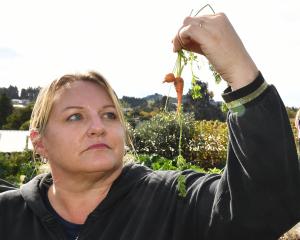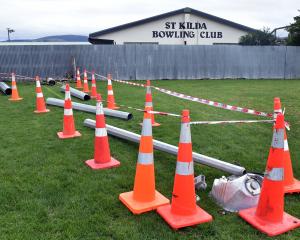Throw out your vegetables. That is one of the messages for South Dunedin residents whose gardens were flooded last week.
Raw sewage contaminated last week's floodwaters, meaning flooded backyards, vegetable gardens and playgrounds could be unsafe.
The Dunedin City Council said those areas needed to be treated or, in many cases, the soil removed. Until that work was done, children and pets should be kept away from them.
Any crops that came into contact with floodwaters should not be eaten, and should be thrown out, the council said.
Hard surfaces needed to be scrubbed with bleach, soils might need to be replaced, and any sewage material, including toilet paper and faecal matter, should be removed.
Gumboots and gloves should be worn when cleaning the areas, and hands and clothes washed thoroughly afterwards, the council said.
Southern District Health Board public health registrar Katherine Graham said a precautionary approach was being taken over how much of the floodwater was contaminated.
The advice was ''to treat all flood-affected areas as being potentially contaminated'' and to take precautions to prevent exposure, she said.
Dr Graham said the bacteria in sewage could cause gastrointestinal illness.
Avoiding exposure was best, but if people came into contact with contaminated areas they should wash their hands with hot soapy water then dry them thoroughly, immediately afterwards, and again before eating or preparing food.
Contaminated clothes should be washed separately in hot water and soap powder.
Even the dust from dried, contaminated silt could lead to respiratory tract inflammation, Dr Graham said.
She said the public health service had not been notified of any hospital admissions linked to the contamination, but if people were concerned they or their children could be sick due to exposure to contaminated floodwaters they should seek advice from their GP.
DCC group manager for water and waste, Laura McElhone, said the council was working hard to make sure people affected by the floodwaters could get help - especially those who were less physically able to remove contaminated objects, or those without insurance.
''We've got a large army of staff and volunteers door-knocking on 6000 properties [today] to see if people need extra help.''
The Mayoral Relief Fund was available for those in need without insurance options, she said.
John Flaherty, of Alma St, St Clair, said his vegetable garden was covered by the floodwaters, but he saw no solid evidence of sewage.
That gave him the confidence to continue tending to his garden this week, and yesterday he ate a lunch including potatoes and carrots from his garden.
He said he understood the floodwaters might have been contaminated, but he was not concerned.
''If it was visible stuff floating around, I would have been a bit more concerned.''
A Hargest Cres resident who did not want to be named said she saw a family fill their car up with flood-damaged goods tossed out by a neighbour.
She said the neighbour had put flood-soiled bedding, carpet, lamps, paint-tins and other small goods beside the road, with the intention of getting it all into a skip.
But the young family pulled up and started loading their car's back seat.
What to do If your section was flooded:
• All affected areas should be hosed down.
• All vegetables grown in gardens covered by the floodwaters should be thrown out.
• Backyards should be hosed down, and soil lime-treated.
• Vegetable gardens should have their soil turned over or, preferably, replaced.
• Any contaminated vegetable garden should not be used for three to six months, unless treated with lime.
• Any fruit that has dropped to the ground should not be eaten.
• Hard surfaces should be hosed down, scrubbed with bleach-based disinfectants, and left to dry completely.












